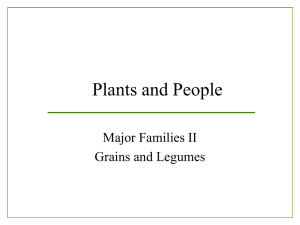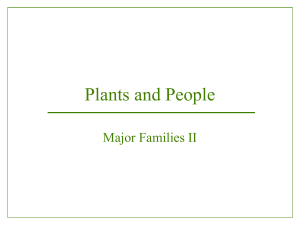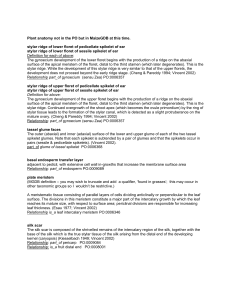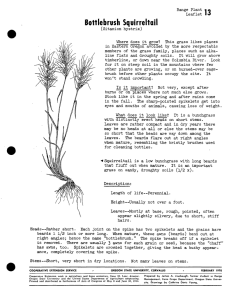Document
advertisement
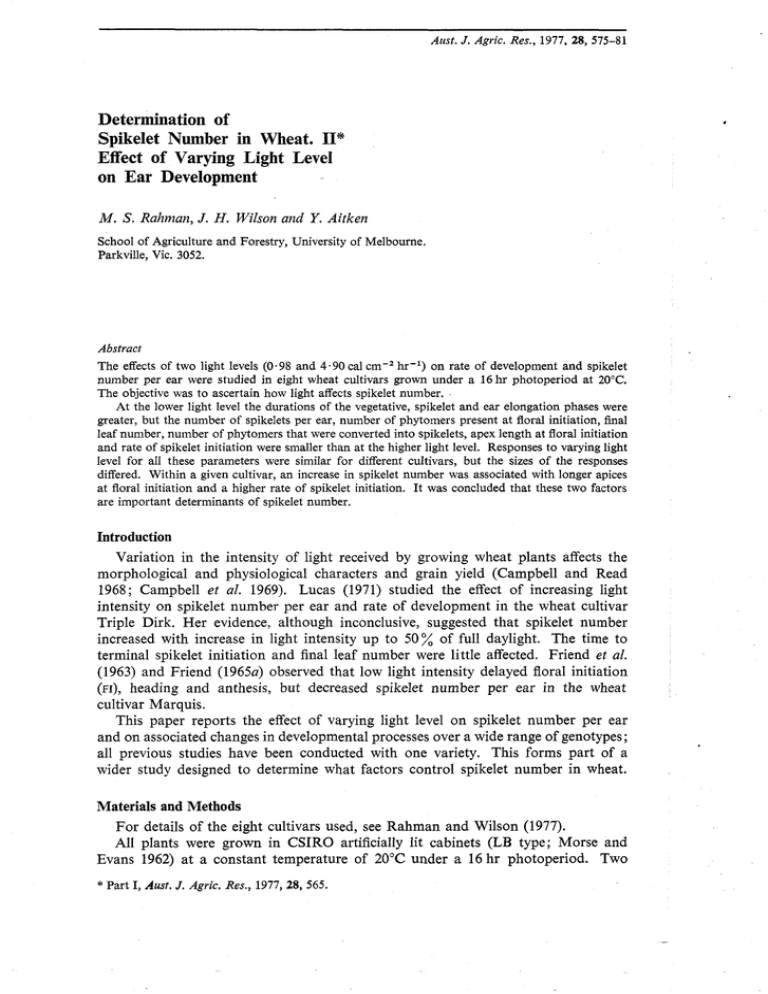
Aust. J. Agric. Res., 1977, 28, 575-81 Determination of Spikelet Number in Wheat. 11% Effect of Varying Light Level on Ear Development M. S. Rahman, J. H. Wilson and Y. Aitken School of Agriculture and Forestry, University of Melbourne. Parkville, Vic. 3052. Abstract The effects of two light levels (0.98 and 4 . 9 0 cal cm-2 hr-') on rate of development and spikelet number per ear were studied in eight wheat cultivars grown under a 16 hr photoperiod at 20°C. The objective was to ascertain how light affects spikelet number. At the lower light level the durations of the vegetative, spikelet and ear elongation phases were greater, but the number of spikelets per ear, number of phytomers present at floral initiation, final leaf number, number of phytomers that were converted into spikelets, apex length at floral initiation and rate of spikelet initiation were smaller than at the higher light level. Responses to varying light level for a11 these parameters were similar for different cultivars, but the sizes of the responses differed. Within a given cultivar, an increase in spikelet number was associated with longer apices at floral initiation and a higher rate of spikelet initiation. It was concluded that these two factors are important determinants of spikelet number. Introduction Variation in the intensity of light received by growing wheat plants affects the morphological and physiological characters and grain yield (Campbell and Read 1968; Campbell et al. 1969). Lucas (1971) studied the effect of increasing light intensity on spikelet number per ear and rate of development in the wheat cultivar Triple Dirk. Her evidence, although inconclusive, suggested that spikelet number increased with increase in light intensity up to 50% of full daylight. The time to terminal spikelet initiation and final leaf number were little affected. Friend et al. (1963) and Friend ( 1 9 6 5 ~ observed ) that low light intensity delayed floral initiation (FI), heading and anthesis, but decreased spikelet number per ear in the wheat cultivar Marquis. This paper reports the effect of varying light level on spikelet number per ear and on associated changes in developmental processes over a wide range of genotypes; all previous studies have been conducted with one variety. This forms part of a wider study designed to determine what factors control spikelet number in wheat. Materials and Methods For details of the eight cultivars used, see Rahman and Wilson (1977). All plants were grown in CSIRO artificially lit cabinets (LB type; Morse and Evans 1962) at a constant temperature of 20°C under a 16 hr photoperiod. Two * Part I, Aust. J. Agric, Re$.,1977, 28, 565. M. S. Rahman et at. 576 light levels were used: 0.98 and 4.90 cal cm-2 hr-l, equivalent to 300 and 1500 ft candles, respectively (16 and 79 cal cm-2 day-'). For the higher light level, 28 fluorescent tubes were supplemented with four incandescent globes (each 60 W) and for the lower level, six fluorescent tubes were supplemented with two incandescent globes. A Kipp solarimeter was used for light measurement, and adjustment was made for the 400-700 nm range. The lower light level was above the compensation point for growth of wheat plants (Friend 1965b). For details of sowing and subsequent growth, measurements (all on main sheet) made, and the method of calculation of the rate of spikelet initiation and of the number of phytomers converted into spikelets, see Rahman and Wilson (1977). Results The number of spikelets was lower at the lower light level in all cultivars (Table 1). However, the effect of reducing light was different for different cultivars. Kogat, which had the highest number (21 -5) at the higher level, had 16.8 (a reduction of 22%) at the lower level. Cultivar 8-23, which had the lowest number (16.3) at the higher level, had 15.5 (a reduction of 5 %) at the lower level. On the other hand in Gabo, which had a low number (16.5) at the higher level, the number fell to 11a8 (a reduction of 28 %). Table 1. Number of spikelets per ear, rate of spikelet initiation, and apex length at FI at two light levels (0.98 and 4.90 cal hr-') in various wheat cultivars grown at a 16 hr photoperiod and a constant temperature at 20°C Cultivar No. of spikelets per ear 4.90 0.98 Rate of spikelet initiation per day 4.90 0.98 Apex length (mm) at FI 4.90 0.98 Triple Dirk Gabo Kalyansona Kogat Thatcher Selkirk 8-23 8-27 A N o terminal spikelet formed. The rate of spikelet initiation was lower and the apex at floral initiation was shorter at the lower level in all cultivars (Table 1). The cultivars differed widely in their response to varying level for both the parameters. There were significant positive correlations between rate of spikelet initiation and spikelet number (r = 0.67""") and also between apex length and spikelet number (r = 0.76***). The numbers of double ridges present at floral initiation remained fairly constant at 4.0 regardless of light level; the only departure from this figure was with 8-27, which had 5.0 double ridges at the higher level, and with Triple Dirk and Gabo, which had 3.0 double ridges at the lower level. Spikelet Number in Wheat. I1 The durations of the vegetative, spikelet and elongation phases for the various cultivars at the two light levels are given in Table 2. Reduction in light led to increases Table 2. Durations of vegetative, spikelet, and elogation phases at two light levels (0.98 and 4.90 cal cm-2 hr-') in various wheat cultivars grown at a 16 hr photoperiod and a constant temperature of 20°C Cultivar Triple Dirk Gabo Kalyansona Kogat Thatcher Selkirk 8-23 8-27 Duration of vegetative phase (days) 4.90 0.98 20.0 23.0 22.0 18.3 23.5 33.5 28.0 25.3 Duration of spikelet phase (days) 4.90 0.98 24.5 33.5 26.8 26.8 27.0 49.5 40.8 46.3 11.0 10.8 10.8 12.8 13.3 16.3 12.0 13.8 (1 %) 0.78 No terminal spikelets formed or ears emerged. q E a e3 0.5 , 0.9 12.5 12.8 13.5 14.5 17.0 25.5 23.0 A 0.91 LSD A Duration of elongation phase (days) 4.90 0.98 23.3 23.5 21.5 24.3 26.0 25.8 25.0 27.5 35.8 34.3 37.5 1.3 1.8 1 A 84.0 A A A I 0.5 1.3 Rate of spikelet initiation per day 0 6 Apex length 0.7 (mm) E I 0 I I 1 20 40 0 Duration 20 40 (days) Fig. 1. Relation between (a) rate of spikelet initiation, (b) apex length at floral initiation, (c) length of the vegetative phase and (d) length of the spikelet phase, and spikelet number per ear in eight wheat cultivars at two light levels (0.98 and hr-I). 0-0 Lower level, 0-0 Higher level. I , Triple Dirk; 4.90 cal 2, Gabo; 3, Kalyansona; 4, Kogat; 5, Thatcher; 6, Selkirk; 7, 8-23. in the lengths of all three phases. Again there were substantial differences between cultivars, both in the lengths of the phases at the higher level and in the effects of M. S. Rahman et al. reducing light on the lengths of the phases. Within cultivars, the effects of reducing the light on the lengths of the phases seemed to be largely independent of one another. For example, in Thatcher, reduction in light level caused only small increases in the duration of the vegetative and spikelet phases, but lengthened the elongation phase from 26.0 days to 84.0 days. Cultivar 8-27 failed to initiate a terminal spikelet, and three others (Kogat, Selkirk, 8-23) failed to produce ears at the lower level. Advantage has been taken of the effects of varying light level on the rate of spikelet initiation, apex length at FI, and lengths of the vegetative and spikelet phases to plot the relation between spikelet number and each of these parameters (Fig. 1). Spikelet number is seen to increase with increase in the rate of spikelet initiation and increase in length of the apex, but to decrease with increase in lengths of the vegetative and spikelet phases. In the absence of information to the contrary, the relations are shown as linear, but we have no evidence that they are not curved. While the elevations of the regression lines vary markedly between cultivars, the slopes for the different cultivars for each of the relations, spikelet number with respect to rate of spikelet initiation and apex length, are remarkably similar. However, with spikelet number in respect to lengths of the vegetative and spikelet phases, there is no constancy between cultivars either in elevation (mean spikelet number) or slope of the relations. Table 3. Number of phytomers present at FI, final leaf number, and number of phytomers that were converted into spikelets at two light levels (0.98 and 4.90 cal ~ m hr-') - ~ in various wheat cultivars grown at 16 hr photoperiod and a constant temperature of 20°C Cultivar No. of phytomers present at FI 4.90 0.98 Final leaf number 0.35 0.51 4.90 0.98 No. of phytomers converted to spikelets 4.90 0.98 Triple Dirk Gabo Kalyansona Kogat Thatcher Selkirk 8-23 8-27 LSD A (1 %) 0.27 Could not be determined. The number of phytomers present at FI, the final leaf number and the number of phytomers that were converted into spikelets are given in Table 3. Reduction in light was accompanied by decreases in all these parameters in most cultivars, but in Selkirk, 8-23 and 8-27 the numbers of phytomers and leaves either increased or changed little. Discussion Control o f Spikelet Number The results of the present investigation show that the direct effect of light can be real and substantial. This accords with the findings of Friend et al. (1963), Friend Spikelet Number in Wheat. I1 (1965a), and Lucas (1971) who have observed that spikelet number increases with increase in light intensity. The more interesting outcome of varying light level has been its effect on correlations between various parameters and spikelet number. Spikelet number has usually been found to be positively correlated with the length of the vegetative phase. Lucas (1972) claimed that the length of the vegetative phase is a direct determinant of spikelet number in wheat. However, in the present study, reducing lig4t increased the length of the vegetative phase but decreased the number of spikelets, i.e. reversed the usual relation between spikelet number and length of the vegetative phase. Another factor which has been proposed as a determinant of spikelet number is the length of the spikelet phase. This has usually been found to be positively correlated with spikelet number (Rawson 1970). However, in the present study, lengthening of the spikelet phase by reducing light has resulted in a decrease in spikelet number, which is again a reversal of the usual trend. It seems clear therefore that neither the length of the vegetative phase nor the length of the spikelet phase can in themselves be critical determinants of spikelet number. Apex length at floral initiation and rate of spikelet initiation are the other factors that might be considered. In experiments with photoperiod, apex length has been shown to be positively associated with the duration of the vegetative phase (Lucas 1972; Rahman and Wilson 1977). Both Lucas and Rahman and Wilson have concluded that apex length at floral initiation is an important determinant of spikelet number. The results of the present study, in which there was a significant positive correlation between apex length and spikelet number (r = 0.76), confirm these findings, but because a considerable proportion of the variation in spikelet number remains unexplained (r2= 0.58) the conclusion that other factors are involved is also suggested. In their study involving changes in photoperiod Rahman and Wilson (1977) concluded that the rate of spikelet initiation is an important determinant of the spikelet number. In the present study, there was a significant positive correlation (r = 0.67) between rate of initiation and spikelet number. The number of phytomers present at floral initiation which become converted to spikelets has also been shown to vary and to be a potential factor, although one of secondary importance, in determining spikelet number (Rahman and Wilson 1977); here the number of phytomers converted to spikelets varied from 1.0 in Selkirk at the lower light level to 4.0 in 8-27 a t the higher level, and there was a positive association between the number of phytomers converted to spikelets and final spikelet number. Within cultivars the number of phytomers converted to spikelets was greater at the higher light level. It seems possible that the proportions of phytomers, uncommitted at floral initiation, which become leaves or spikelets may depend on the relative rates of differentiation of leaves and spikelets, i.e. an increase in rate of spikelet initiation (differentiation) relative to rate of leaf differentiation might result in a greater proportion of uncommitted nodes supporting spikelets. Although in - ~ this experiment increasing the light level from 0.98 to 4.90 cal ~ r n hr-hesulted in increases in both rate of leaf initiation (final leaf number divided by the length of the vegetative phase) and rate of spikelet initiation, at the higher level rate of spikelet initiation was about three times as fast as leaf initiation, but at the lower level it was only about twice as fast. M. S. Rahman et al. Practical Implications The cultivars differed greatly in their tolerance to low light, Kogat, Thatcher, Selkirk, 8-23 and 8-27 being more affected in the elongation phase. In Australia and India (latitude 27-37") wheat is grown during winter and therefore under low light intensity and short photoperiod. In higher latitudes (50-65") such as in northern Europe, Canada and Alaska, and in the high altitudes of Afghanistan (72000 m), wheat is grown during summer and therefore under high light intensity and long photoperiod. The present results suggest that the wheats selected for early maturity in the winter-spring growing seasons of moderate latitudes were unwittingly selected for tolerance to low light intensity as well as to short photoperiod. The finding that wheat cultivars differ in their reaction to low light should be considered in breeding programs. Although the light level available in the field during the Australian winter is far higher than the low level used in the present study, light intensity could become critical because of shading from weeds or mutual shading by the wheat seedlings themselves during the spikelet initiation phase, and thus could restrict spikelet number. This aspect of competition: should be considered in regard to both the management of the crops and the possibility of producing cultivars with higher spikelet number which are more tolerant of low light intensity. The experiment was conducted under only two light levels, the higher level being 80% of mean daily light in winter. Furthermore the photoperiod used was higher than that of the mean winter months in southern Australia. The responses to light observed may be smaller than might be observed if a greater range of light level was used. Experiments with a greater range of light levels and shorter photoperiods (e.g. 12 hr) might be rewarding. Acknowledgments The authors are grateful to Mr G. M. Halloran of the School of Agriculture and Forestry, University of Melbourne, for his helpful comments on the manuscript. References Aitken, Y. (1974). 'Flowering Time, Climate and Genotypes.' (Melbourne Univ. Press.) Campbell, C. A,, and Read, D. W. L. (1968). Influence of air temperature, light intensity and soil moisture on the growth, yield and some growth analysis characteristics of Chinook wheat grown in the growth chamber. Can. J. Plant Sci. 48,299-311. Campbell, C. A., Pelton, W. L., and Nielsen, K. F. (1969). Influence of solar radiation and soil moisture on growth and yield of Chinook wheat. Can. J. Plant Sci. 49, 685-99. Friend, D. J. C. (1965~).Ear length and spikelet number of wheat grown at different temperatures and light intensities. Can. J. Bot. 43, 345-53. Friend, D. J. C. (19656). The effects of light and temperature on the growth of cereals. In 'The Growth of Cereals and Grasses,' ed. F. L. Milthorpe and J. D. Ivins, pp. 181-99. Friend, D. J. C., Fisher, J. E., and Helson, V. A. (1963). The effect of light intensity and temperature on floral initiation and inflorescence development of Marquis wheat. Can. J. Bot. 41, 1663-74. Hake, N. J. and Weir, R. N. (1970). Effects of vernalization, photoperiod, and temperature on phenological development and spikelet number of Australian wheat. Aust. J. Agric. Res. 21, 383-93. Lucas, D. (1971). Effects of the environment on morphogenesis of the shoot apex in wheat. Ph.D. thesis, University of Adelaide. Lucas, D. (1972). The effect of daylength on primorida production of the wheat apex. Aust. J. Biol. Sci. 25, 649-56. Spikelet Number in Wheat. I1 58 1 Morse, R. N., and Evans, L. T. (1962). Design and development in CERES-anAustralian phytotron. J. Agric. Eng. Res. 7 , 128-40. Rahman, M. S., and Wilson, J. H. (1977). Determination of spikelet number in wheat. I. Effect of varying photoperiod on ear development. Aust. J. Agric. Res. 28, 565-74. Rawson, H. M. (1970). Spikelet number, its control and relation to yield per ear in wheat. Aust. J . Biol. Sci. 23, 1-15. Wall, P. C., and Cartwright, P. M. (1974). Effects of photoperiod, temperature and vernalization on the phenology and spikelet numbers of spring wheats. Ann. Appl. Biol. 76,299-309. Manuscript received 16 November 1976
